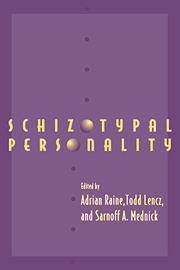Book contents
- Frontmatter
- Contents
- List of contributors
- Preface
- Acknowledgments
- Part I Introduction
- Part II Genetics and neurodevelopment
- Part III Assessment
- 5 Scales for the measurement of schizotypy
- 6 Schizotypal status as a developmental stage in studies of risk for schizophrenia
- Part IV Categorical versus dimensional approaches
- Part V Psychophysiology and psychopharmacology
- Part VI Neuropsychology
- Part VII Brain imaging
- Part VIII Conclusion
- Part IX Appendix
- Name Index
- Subject Index
6 - Schizotypal status as a developmental stage in studies of risk for schizophrenia
from Part III - Assessment
Published online by Cambridge University Press: 04 August 2010
- Frontmatter
- Contents
- List of contributors
- Preface
- Acknowledgments
- Part I Introduction
- Part II Genetics and neurodevelopment
- Part III Assessment
- 5 Scales for the measurement of schizotypy
- 6 Schizotypal status as a developmental stage in studies of risk for schizophrenia
- Part IV Categorical versus dimensional approaches
- Part V Psychophysiology and psychopharmacology
- Part VI Neuropsychology
- Part VII Brain imaging
- Part VIII Conclusion
- Part IX Appendix
- Name Index
- Subject Index
Summary
This chapter is concerned with the extent to which schizotypal status, which can be considered as productive of risk for later schizophrenia, may be more or less directly related to the type of schizophrenic status that the patient may eventually reach.
This problem may be approached in the first instance by examining the extent to which the divisions of schizophrenic symptomatology have parallels in dimensions of schizotypy. One of the origins of work on schizotypy is the seminal paper of Meehl (1962), who suggested that the common predisposition “schizotaxia” – an “integrative neural defect” (p. 829), “all that can properly be spoken of as inherited” (p. 830) – underlies both schizotypy and schizophrenia. Thus there is in this a clear suggestion that there is a commonality between schizotypy and schizophrenia in that their etiology is similar and, given the appropriate malign circumstances, schizotypy can develop into schizophrenia. It may thus be appropriate to think that the characteristics shown by schizotypics will have some relationship to those shown by schizophrenics, and that where schizotypic status is used as an indicator of increased risk for schizophrenia, the patient may develop the type of schizophrenia that is akin to those schizotypic characteristics shown in the premorbid state.
However, it is permissible to question this proposition, insofar as the characteristics shown by schizophrenics may be the result of growing up with a schizotypal personality which makes the “patient-to-be” less acceptable to his fellows; hence, for instance, the withdrawal shown by the schizophrenic patient may therefore be a secondary reaction to the “oddness” shown in the premorbid state.
Keywords
- Type
- Chapter
- Information
- Schizotypal Personality , pp. 107 - 132Publisher: Cambridge University PressPrint publication year: 1995
- 5
- Cited by

